
QUAD and the Indo-Pacific: The geopolitical move of the decade
Published 14 Sep. 2021 by Jasmine Mehta under International Strategic Studies and Originally Published on QUAD Forum
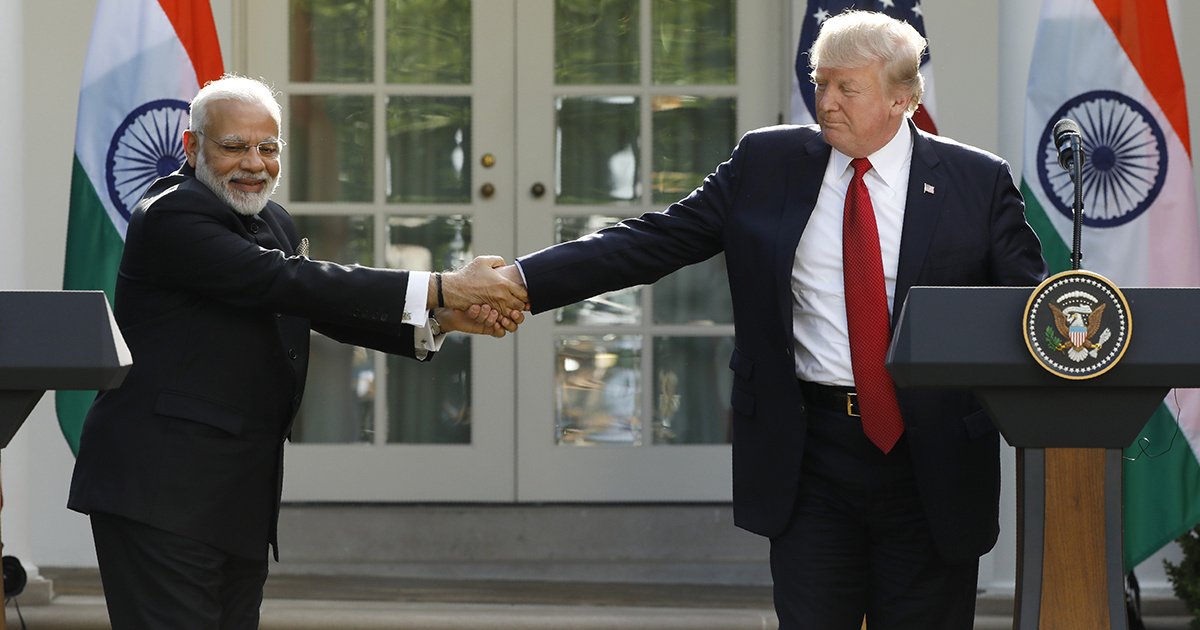
Part 1: South China Sea and the United States
Thirst for resources, territorial acquisitions and consequential disputes have historically resulted in armed conflicts and wars worldwide. Territorial claims transitioned from the West to Asia by the end of the 19th Century (Frederick, Hensel and Macaulay 2017). In that breadth, the South and East China Seas house a clash of sovereignty claims, of the many islands and EEZs between China, Taiwan, Vietnam, Philippines, Malaysia, Indonesia, Brunei, Japan and South Korea. “EIA estimates there to be approximately 11 billion barrels (bbl) of oil reserves and 190 trillion cubic feet (Tcf) of natural gas reserves” underneath the seabed (U.S. Energy Information Administration 2015). Dispute resolution of sovereignty claims are complex for lack of clarity of its ownership, interpretation and application in multiple treaties and enforcement of international law (Anh 2015).
Geospatial imagery has confirmed China’s quick action on reclaiming land to build airstrips, military bases and ports in the Spratly (seven outposts) and Paracel Islands (twenty outposts), to secure natural resources in the region. In response, the US has warned China to stop the unlawful expansion by conducting FONOPs since 2017. (Council On Foreign Relations 2020). Additionally, China has planted military assets against Japan in the East China Sea (Hornung 2020).
Significant events in 2020:
- In February 2020, Philippines’ President Duterte enforced cancellation of the U.S.-Philippines Visiting Forces Agreement (VFA), hurting US’ ability to conduct FONOPs through the Philippines EEZ (Grossman, 2020). Six months of saving the deal is expected to be underway as military and bipartisan senior officials have been attempting to revive the VFA (Grossman, 2020). As a pre-emptive response, US State Department has pre-approved the sale of defense helicopters to Philippines, such that transfer of sale would be expedited when confirmed (Mehta 2020).
- In March 2020, US officially recognised Taiwan as an independent country and signed the TAIPEI Act, which included US defense sales to Taiwan, while disavowing the OneChina policy. Subsequently, Taiwan’s Ministry of Foreign Affairs confirmed China’s People’s Liberation Army (PLA) attempt to violate Taiwanese air and water zones (Rajagopalan 2020).
- Vietnam lodged a formal complaint to China as a Chinese surveillance vessel rammed into Vietnamese shipping boat near the disputed Paracel Islands on April 3, 2020. In response, US issued a press statement condemning the Chinese foul act and while not recognizing sovereignty of its nine dash line, while confirming China’s continued and aggressive militarization of the Fiery Cross Reef and Subi Reef(US Department of State 2020). However, the Chinese remain determined to capture territory within the nine-dash line.
- Further, China’s exploration vessel, Haiyang Dizhi 8, entered Malaysian waters to likely damage Petronas’s oil drilling operations in West Capella on April 17, 2020. However, the Chinese Foreign Ministry refuted the claim of an intentional damage to the Petronas vessel instead, stated Haiyang Dizhi 8 was on exploration business as usual. Further, Malaysian security witnessed 10 additional Chinese vessels along with a Vietnamese vessel, bringing all 3 claimants of the sea section, head on(Ananthalakshmi and Latiff 2020).
- Following the Petronas ship tailing incident, USS Montgomery and USNS Cesar Chavez have been conducting more FONOPs in West Capella. Additionally, US Air Force bombers and Australian naval fleets have been posturing through South China Sea to refrain China from its bullying activities (Pickrell 2020).
Broader US- China relations:
Looking at the larger picture, US China relations have gone south with US’ shift in policy towards China since 2017. President Trump’s administration has enacted a US protectionist policy while reducing trade deficits with China by means of a Trade War. While Phase I of the agreement is signed, Phase II is a trump card to leverage whilst negotiating on resource sharing underneath the South China Sea.
COVID–19:
When the world is grappling to contain COVID-19, China has been resorting to various coercive measures against its neighbors in the South China Sea, as highlighted above (Hille and Reed 2020). On the other hand, China’s COVID-19 mask and ventilator assistance is nothing more than “Mask Diplomacy” - a cover up to coax neighbors to discount it’s bullying in the South China Sea (Hornung 2020). China’s “Might is Right” policy should be condemned globally for the overall wrong it does in the name of its own good (Chellaney 2016).
US Strategy:
US stance in the South China Sea conflict has gained priority in US Foreign Policy and US Department of Defense, over the last few years. President Trump’s administration has garnered significant progress in terms of policy actions with the QUAD and bilateral relations with South China Sea’s littoral countries. Core US objectives in the disputed South China Sea region are as follows:
- Maintain Free and Open Indo-Pacific Ocean
- Maintain US hegemony and overall stability in the South China Sea
- Support interests of US allies and partners in the Indo-Pacific region (The Department of Defense 2019)
Key US interests underpinning its objectives in the South China sea conflict and broader Indo-pacific region are highlighted as follows:
Economic Interests: Unobstructed and open access to trade routes aerial, land and shipping lines across the Indo-Pacific have enabled the following (The Department of Defense 2019)
USD 2.3 TN worth two-way trade between US and Asian countries through Asia-Pacific Economic Cooperation (APEC).
· USD 1.3 TN worth US foreign direct investment in the region.
· 25% of US exports are shipped to Indo-Pacific with exports to India and China more than doubling through the past decade.
· Thus, there looms a global trade risk with China’s attempt to monopolize shipping routes of more than 1/3rd global trade.
Military Interests:
· US is warranted to honor defense agreements with Japan and Philippines and protect the littoral countries on account of enormous security risks they face, due to interference in their EEZs and mighty militarization of islands and seas, by China in the garb of its sovereignty (Council On Foreign Relations 2020).
Political Interests: US as the founder of the rules based international order, will not allow China to breach freedom of navigation and compromise lawful shipping access in the South and East China Sea, in order to maintain overall stability, peace and prosperity in the Indo-Pacific. (The Department of Defense 2019)
QUAD:
An unofficial and non-confrontational Indo-Pacific defense framework allows Japan, India and Australia to partner with the US in regulating the Indo-Pacific Ocean, while containing China. (Medcalf 2019). The 2008 framework of a free, independent and open pacific has been addressed and implemented by each member-state of the Quad with limited outcomes. Post 2016, China’s aggression and exploration in South China Sea has increased many folds. To keep up, QUAD requires restructuring both in terms of its membership and scope of collaboration, to successfully push back Chinese aggression and stabilize the region (Grossman, 2018).
Issues
South and East China Sea conflicts have topped conflict zones, making it a hotbed of geopolitical and security risks with severe implications (Council On Foreign Relations 2020). China’s rise and attempt to overturn the balance of power in the region, threatens US hegemony and poses the following risks (Council on Foreign Relations 2020):
1. Security risk escalation for US allies in East Asia due to Chinese militarization of disputed land and water territories to claim sovereignty.
2. Chinese violation of international rules-based order- United Nations Convention on the Law of the Sea (UNCLOS) - of its neighbours’ exclusive economic zones (EEZs).
3. Once fully militarized by the Chinese, global trade will be at imminent risk if China monopolizes shipping routes through which 1/3rd of global trade passes.
While conflicts in South and East China Seas don’t pose an immediate direct security threat to US, its defense agreements with Japan and Philippines should be honoured in case conflicts escalate to war (Council On Foreign Relations 2020). As these conflicts don’t undermine US sovereignty per se, an all-out war is an unwarranted option for the time being.
Policy Recommendation: US should counterattack China’s foul play, by reinvigorating, reforming and expanding the scope of Quadrilateral Security Dialogue (QUAD) as an official defense and economic bloc. This will sufficiently restrain China from further militarization and create a favourable shift in the regional balance of power for the US.
Outcomes of no war, Chinese military deterrence, open shipping lanes and favourable economic gains are only possible via QUAD2.0, allowing for continued economic prosperity to US while successfully limiting expenditure in the region. On the other hand, revival of US alliance with Asian states will allow for limited benefits to US while demanding more expenditure yet failing to deter Chinese militarization.
Implementation: China’s assertiveness has intensified when the world is COVID-19 affected. US must act now to re-stabilize the South East Asian continent. US should take the mantle and engage, empower and evolve QUAD2.0 relations, in order to secure long-term US interests, by creating various counters to China’s rise and balance of power.
Assumptions: China will escalate conflicts to appease domestic audience but will not approach US with war, basis sheer might of US defense and its strong military alliances worldwide. All QUAD2.0 members are sufficiently incentivized to increase investments in this policy, on account of the security and economic risks each face from China.
Desirable outcome for US: Restrain China from bullying its neighbors and militarizing the South and East China Sea. Enforce international law (UNCLOS) in the region to allow for uninterrupted global access to international shipping lanes, to ensure US supply chains remain in Asia. A united QUAD2.0 leverages all tools in the foreign policy playbook (ex-war) to be able to achieve US objectives.
COVID-19: China’s harsh behavior in the South China Sea, against its neighbors, adding to the plight of the pandemic of it’s causing and global diffusion, is a golden opportunity for the US to reinstate its hegemony in Asia. The time is right for US to aggressively sow seeds of democracy in China with an ultimate goal to substitute communism, while saving Asian countries of communist atrocities.
Reaction from China: A scenario of increased bullying in the South China Sea culminating into conflict will most likely be China’s immediate response. Beyond which, it may attempt to disrupt the US-China trade deal, create obstacles for the exit of US supply chains fracturing US businesses, propagate disinformation campaigns in US ahead of elections, launch cyber-attacks on the US and dump US treasury. Further, Russia may covertly support China in these response actions against US. China can discontinue essential exports to Japan and Australia while drastically reducing imports. China may send its naval vessels to the Sea of Japan and Papua New Guinea as a preview of retaliatory action. Against India, China will likely attempt to escalate conflicts at Indian borders and accelerate nuclear inducements to Pakistan with an anti-India agenda.
POLICY OPTIONS (Rationale)
Geopolitical and security risks arising from escalated conflicts in South China Sea are amplifying, with serious implications for the world. More state actors fighting for common land and waters makes the situation acutely complex. To secure interests underpinning US objectives in the Indo-Pacific, this document sets out three foreign policy options (means), with likely outcomes, and analyses the merits, demerits and assumptions.
Policy Option 1: QUAD

Likely Outcomes:
· Short Term: Impact on US elections will likely be positive on the basis of concrete steps taken to counter Chinese aggression, in the region. US will enjoy maximum political, economic and trade benefits with minimum and shared military costs.
· Long Term: A strong and united QUAD2.0 will, for the coming decades, successfully maintain the balance of power in the region, in favour of US, while containing China. QUAD2.0 can be one of the most powerful blocs globally, based on a strong plinth of democratic societies and shared values.
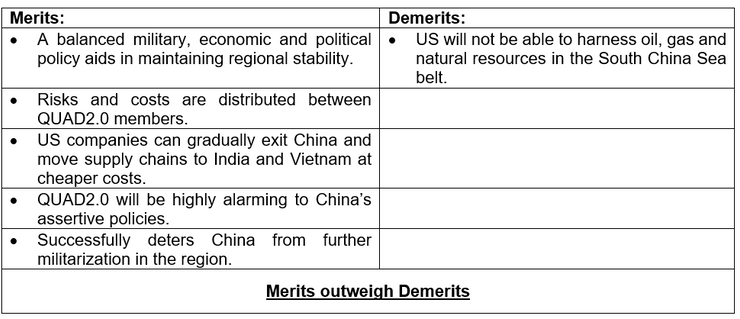
Assumptions: China will refrain from going to war with US, as China comprehends US' capabilities to seize South China Sea altogether in an event of total war.
Policy Option 1: US Pivots to Asia-Pacific/ASEAN
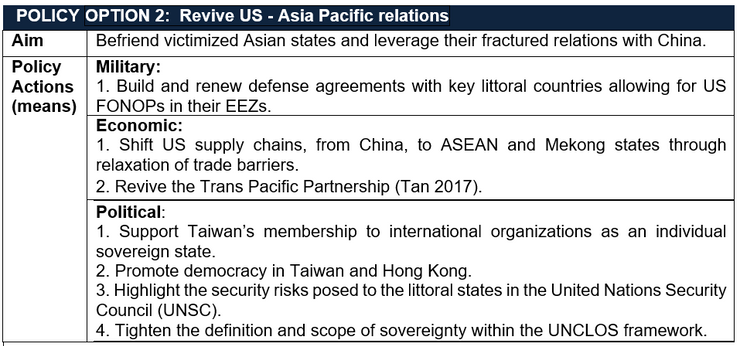
Likely Outcomes:
· Short Term: Impact on US elections are likely low for there is no direct military confrontation or high value economic implications that would cost the US in the near term.
· Long Term: Overall, slow moving process involving many state actors with an even slow, slightly positive, outcome. This coupled with fast and autocratic decision making and implementation by the Chinese will very likely defeat US in all its objectives, making the policy rather redundant.

Assumptions: China will not be able to resolve disputes with neighboring countries bilaterally. All Asian states will continue supporting US lead on this conflict and neither state will be swayed towards China.
Policy Option 3: US Militarization to Secure South China Sea Region
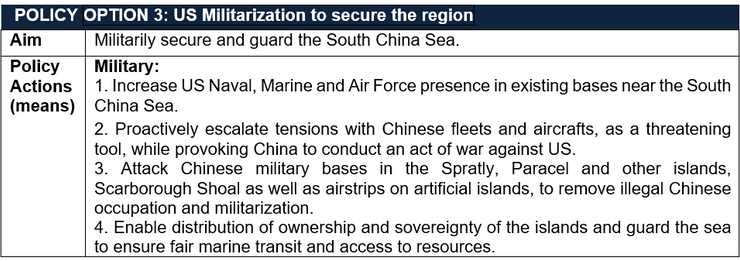
Likely Outcomes:
· Short Term: Battle ready US military coupled with state-of-the-art defense technology, will certainly allow US to win the war and capture the islands securely and swiftly. But there is enormous risk of China’ appropriate retaliation. Also, this daring mission will cost much more than its immediate rewards. Such a military exercise has an inherent risk on US elections, depending on the success of the mission and associated damages.
· Long Term: Just like in the Middle East and Afghanistan, a military intervention in the hope of stabilization may escalate further instability for a longer tenure, in the region. US relations with China will be of hatred, with a fragile South East Asia, running counterproductive to US interests and objectives.
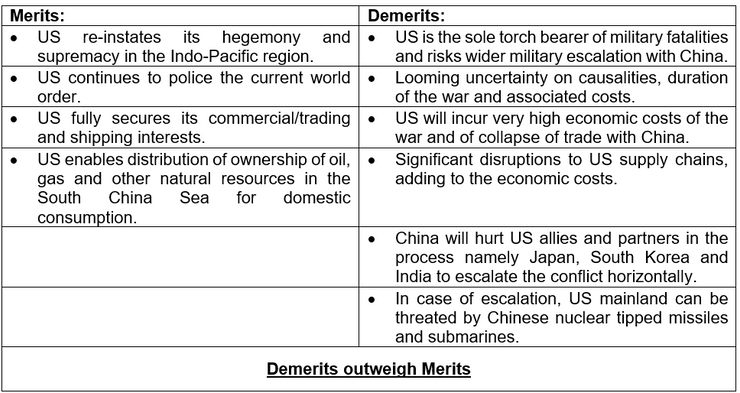
Assumptions: China with its current defense stock and experience, will not be able to take out US from its backyard.
Based on the above analysis, a revival of QUAD seems to be a viable policy option for the US to move ahead with.
Part 2: QUAD - the Geopolitical Imperative
Hunt for economic resources coupled territorial acquisitions, yielding consequential disputes have historically resulted in armed conflicts and wars worldwide. Territorial claims proliferated from the West to Asia by the end of the 19th Century. In that breadth, the South and East China Seas house a clash of sovereignty claims, of the many islands and Exclusive Economic Zones (EEZs) between China, Taiwan, Vietnam, Philippines, Malaysia, Indonesia, Brunei, Japan, and South Korea. These could potentially compromise the lines of communication in the broader Indian Ocean.
South and East China Sea conflicts have topped conflict zones, making it a hotbed of geopolitical and security risks with severe implications. China’s rise and attempt to overturn the balance of power in the region also threatens US hegemony and potentially poses the following risks:
1. Security risk escalation for US allies in East Asia due to Chinese militarization of disputed land and water territories to claim sovereignty.
2. Chinese violation of international rules-based order- United Nations Convention on the Law of the Sea (UNCLOS) - of its neighbours’ EEZs.
3. Once fully militarized by the Chinese, global trade will be at imminent risk if China monopolizes shipping routes through which 1/3rd of global trade passes.
QUAD:
An unofficial and non-confrontational Indo-Pacific defense framework allows Australia, India Japan, and US to partner in regulating the Indo-Pacific Ocean, while containing China. The 2008 framework of a free, independent, and open pacific has been addressed and implemented by each member-state of the Quad with limited outcomes. However, QUAD has been re-activated as domestic and foreign policies have re-aligned (realpolitik) since 2016 towards a shared goal.
In March 2021, QUAD – Head of States met to roll the agenda and the states show a strong commitment from all members to increase FONOPs and collaborative efforts to maintain a Free and Open Indo-Pacific. Matters expanding the scope of QUAD beyond security dialogue to economic aspects such as trade, technology and climate change were classified as other means for collaboration. A promising agenda and implementation by the QUAD shall be pivotal to geo-politics this decade and shall set the story for the remainder of the century.
Recent incidents jeopardising a Free and Open Indo-Pacific (FOIP):
Vietnam, Malaysia, Philippines, and other littoral countries have been facing increasing Chinese naval aggression in sovereign territorial claim throughout the South China Sea. In April 2020, Vietnam lodged a formal complaint to China as a Chinese surveillance vessel rammed into Vietnamese shipping boat near the disputed Paracel Islands. In response, US issued a press statement condemning the Chinese foul act and while not recognizing sovereignty of its nine-dash line, while confirming China’s continued and aggressive militarization of the Fiery Cross Reef and Subi Reef. However, the Chinese remain determined to capture territory within the self-proclaimed nine-dash line, even though the UN Tribunal at the Hague has denied its legitimacy.

Image: China US Focus
Many such incidents have propelled QUAD to be revived since 2016 and increase joint operations within FONOPs such as the Malabar Exercise.
Quad – A Rationale:
Dispute resolution of sovereignty claims are complex for difference of opinion of its ownership, interpretation and application in multiple treaties and enforcement of international law (Anh 2015). In the case of the South China Sea, China has claimed all territories within its nine-dash line, most of which rebuts the United Nations Convention on the Law of the Sea (UNCLOS) determined 200 nautical miles from Mainland China’s shoreline.
Mutual Enemies Make Great Friends: Increasing tension in the South China Sea openly challenges the purpose of the QUAD, but beyond that it poses significant challenges to the neighbouring countries and the regional and global powers – namely Australia, India, Japan, and US. Australia remains highly concerned with Chinese vessels near its shores and the recent alliance between Solomon Islands and China. Japan, on account of historic conflicts and close proximity to China, has been extremely cautions from a territorial perspective but also, it’s reliance on the lines of communications for trade with East Asian countries. India too has had historic territorial conflicts with China with an on-going Doklam conflict on India’s North East border. US stands to face hegemonic crises with China’s rise and likely obstruction of trade through the South China Sea, given its overreliance in the region.
With a common and shared issue or risk of a monopolized Indo-Pacific, affecting all QUAD members and the rest of the world, this issue is a transnational one. Such issues are generally remediated through multi-lateral institutionalism vis-vis bilateral arrangements. Regime theory’s school of thought points to QUAD having the most impact to a Free and Open Indo-Pacific. In reality, QUAD has laid a strong foundation but if it remains short of innovation and implementation, it could leave an unfathomable opportunity cost to QUAD members and perhaps the rest of the world. In order to fully achieve its objective, QUAD requires restructuring both in terms of its membership and scope of collaboration. Only a well-oiled QUAD can achieve its objective of a free and open Indo-Pacific.
QUAD Plus:
QUAD’s military, political and economic interests remain aligned, but the question of sufficiency remains. But other middle power countries – France & Canada – will be conducting FONOPs in the Indian ocean in April 2021. An official response from China is yet to be released on this new development. Korea hasn’t made it to the QUAD list despite speculation. But a formal member inclusion to make QUAD a Pentagon could be a bigger boost for the mission.

Jasmine Mehta
Jasmine is a Fellow at Global Policy Insights and a Co-Chair at the Indian Women in International Relations Forum. She also serves as the Head ESG Issuer Communications - EMEA, MSCI. As EMEA Lead for ESG Issuer Communications, Jasmine engages on ESG issues with corporates rated and researched by MSCI ESG Research to educate them on their MSCI ESG assessments, raise standards for sustainability disclosures, and explain how investors use ESG criteria in investment decision making. Prior to this, she was responsible for ESG Marketing in APAC and global execution of ESG marketing strategies, at MSCI. She holds a Masters in Capital Markets, Regulation, and Compliance from the ICMA Centre, University of Reading, UK and is pursuing an Exec. Masters in International Strategy and Diplomacy from the London School of Economics and Political Science.
Events
- Vanguards in the 21st Century: Optimising Commonwealth Networks
- Global Policy Insights was represented on the prestigious platform
- UK South Asia Educational Partnerships
- Panel Discussion: ‘Brexit’- opportunities UK & Tamil Nadu, India
- Dialogue on Article 370 – What is next for Jammu and Kashmir?
- POST-BREXIT WORLD: UK AND THE COMMONWEALTH
